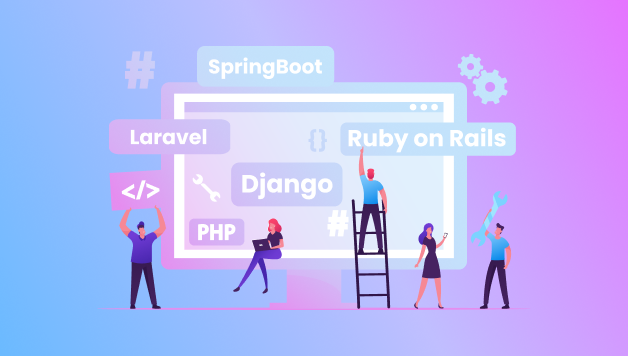In today’s rapidly evolving tech landscape, developers are constantly seeking tools that help them work efficiently and effectively. With businesses demanding faster development cycles and robust performance, choosing the right backend framework can make a world of difference. Backend frameworks streamline the process of building, deploying, and maintaining applications, empowering developers to focus on innovation rather than repetitive tasks. In this blog, we explore some of the top backend frameworks that not only accelerate coding but also enhance the overall development experience.
What Are Backend Frameworks?
Backend frameworks are libraries or tools designed to simplify server-side programming. They provide predefined solutions for tasks like database management, API creation, and user authentication. By offering a structured and reusable codebase, these frameworks save time and effort, enabling developers to concentrate on the application’s unique features.
Why Backend Frameworks Are Essential
For any application, the backend acts as the powerhouse. It handles user requests, processes data, and ensures seamless communication between the front-end interface and databases. The best backend frameworks improve coding speed, promote best practices, and provide security measures right out of the box. They also reduce the complexities of handling common tasks, making development smarter and easier.
Factors to Consider When Choosing a Backend Framework
- Scalability: Ensure the framework can handle your project’s growth.
- Performance: Look for frameworks optimized for speed and efficiency.
- Community Support: Strong community backing ensures regular updates and troubleshooting assistance.
- Learning Curve: Choose a framework that aligns with your team's expertise.
Top Backend Frameworks to Elevate Your Development Process
1. Node.js
Node.js isn’t a framework but a runtime environment powered by JavaScript, and it forms the base for several popular frameworks like Express.js. Known for its event-driven architecture and non-blocking I/O operations, Node.js is perfect for real-time applications like chat apps and online gaming.
Why Use Node.js?
- Lightweight and fast.
- Strong community support and regular updates.
- Great for microservices and scalable applications.
2. Django
Django is a high-level Python-based backend framework that prioritizes rapid development and clean, pragmatic design. With its “batteries-included” philosophy, it provides almost everything developers need for a robust web application.
Key Features of Django:
- Built-in admin interface for management tasks.
- Scalable and secure by default.
- Ideal for projects requiring complex functionalities.
3. Laravel
Laravel is one of the most popular PHP frameworks, making PHP Web Development more elegant and efficient. With features like Eloquent ORM and Blade templating, Laravel simplifies common backend tasks, including authentication and routing.
Why Laravel Stands Out:
- Intuitive syntax and developer-friendly tools.
- Extensive library of pre-built features.
- Active community with detailed documentation.
4. Spring Boot
If you’re working with Java, Spring Boot is a go-to choice among backend frameworks. It allows developers to create production-ready applications with minimal boilerplate code.
Benefits of Spring Boot:
- Simplifies dependency management.
- Offers powerful tools for building RESTful APIs.
- High compatibility with cloud platforms.
5. Ruby on Rails
Ruby on Rails, or simply Rails, is a backend framework that emphasizes convention over configuration. It speeds up development with its predefined patterns and promotes clean, maintainable code.
Why Choose Ruby on Rails?
- Quick prototyping capabilities.
- Active community with extensive resources.
- Built-in tools for testing and debugging.
6. Express.js
As a minimal and flexible backend framework for Node.js, Express.js is a favorite for developers building lightweight and high-performing applications.
Features That Make Express.js Popular:
- Middleware support for managing requests.
- Works seamlessly with frontend frameworks like React and Angular.
- Minimal setup, allowing developers to start quickly.
7. Flask
Flask is a lightweight Python backend framework, perfect for small to medium-scale projects. Its simplicity makes it a popular choice among beginners and experienced developers alike.
Key Advantages of Flask:
- Highly customizable and flexible.
- Lightweight, making it ideal for microservices.
- A rich ecosystem of extensions.
The Future of Backend Frameworks
With the constant advancements in technology, backend frameworks are also evolving to meet new challenges. The rise of serverless architectures, cloud-native development, and AI integrations are shaping the future of backend development. Choosing a framework that aligns with your project’s requirements and future goals can save significant time and resources.
Conclusion
Selecting the right backend framework is crucial for building efficient, scalable, and high-performing applications. Whether you’re a startup aiming for rapid development or an enterprise focusing on stability and scalability, there’s a framework tailored to your needs. From the flexibility of Flask to the power of Laravel, these tools are designed to make coding faster, smarter, and easier.
Embrace the right framework, and watch your development process transform into a seamless and productive experience.





Comments